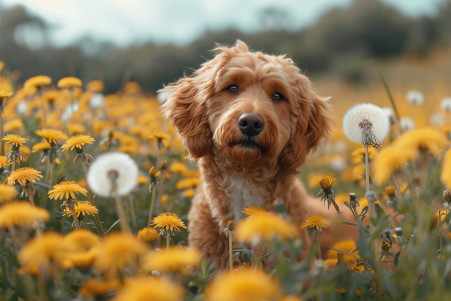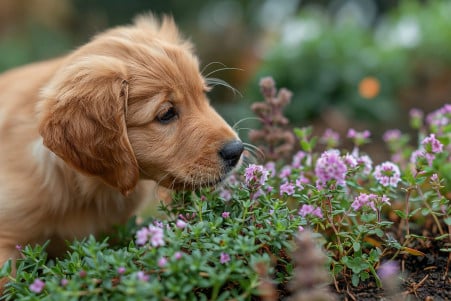Is Weed and Feed Safe for Dogs? What Pet Owners Need to Know
17 May 2024 • Updated 15 May 2024

If you're asking yourself this question, you're probably looking for information on the safety of your dog when it comes to using weed and feed products in your yard. This article will help you understand the risks and safety measures you should consider. Weed and feed products are made up of herbicides and fertilizers, both of which can be toxic to dogs if they are eaten. Even if they are not ingested, the chemicals can cause symptoms like vomiting, diarrhea, drooling, and lethargy. Ingesting large amounts can even lead to more severe symptoms. It is recommended that you keep dogs away from treated areas until the chemicals have dried and been absorbed.
While weed and feed products are made with their intended uses in mind, we will discuss the pros and cons of these products for pets based on information from veterinary toxicologists, lawn care professionals, and animal health organizations. By reviewing the most recent information, this comprehensive article will help you decide whether or not these combination lawn products are safe to use around your dog.
Is weed and feed safe for dogs?
When to Apply Weed and Feed Products and Safety Measures
For liquid weed killers, it’s important to wait 30 minutes to an hour after application for the product to dry before letting pets back onto the lawn, per lawn care professionals. Meanwhile, granular fertilizers and pre-emergent herbicides require a waiting period of about 24 hours for the products to be absorbed into the soil before pets and children can walk on the treated area. This allows the lawn to be watered and the soil to absorb the nutrients and weed control, according to the same lawn care guide.
Weed control products used by professional lawn care companies are applied in a targeted manner, which is generally safer for pets than the more widespread application that often comes with DIY products. As West Park Animal Hospital notes, however, chemical residues from weed killers can remain on surfaces for up to 48 hours after application, even if the product is labeled as pet-friendly.
To reduce the risk of exposure, it’s important to read and follow the instructions that come with the product. While it’s best to choose products that are safe for pets, it’s important to note that even some products labeled as “organic” or “all-natural” may contain toxic ingredients like permethrin, as explained by West Park Animal Hospital. The bottom line is that it’s important to be cautious and well-informed about the specific products that are being used to ensure the safety of your lawn and your pets.
Common Ingredients to Look Out for in Weed and Feed Products
Many weed and feed products contain herbicides such as 2,4-D, glyphosate, and paraquat, which have been associated with an increased risk of certain cancers in dogs in studies conducted by Dr. Lauren Trepanier, a professor of internal medicine at the University of Wisconsin-Madison School of Veterinary Medicine (Humane Society). Fertilizer ingredients like nitrogen, phosphorus, potassium, bone meal, blood meal, iron, nitrates, and urea can lead to gastrointestinal upset, methemoglobinemia, and other issues if ingested in large quantities by pets, according to the Pet Poison Helpline.
Even some "organic" or "all-natural" products may contain ingredients that are harmful to pets, such as permethrin, which is toxic to pets, according to the West Park Animal Hospital. The danger of exposure to these products depends on the specific chemicals involved and the amount, duration, and route of exposure. Early decontamination is particularly important for some products, such as bone meal, to avoid blockages if pets ingest them, according to the Pet Poison Helpline.
Pet-Friendly Alternatives to Weed and Feed
Many pet-friendly weed control products are made with natural ingredients like vinegar, citric acid, clove oil, or saltwater, according to information on pet-friendly lawn care products. Meanwhile, corn gluten meal can be used as a natural weed control, and organic fertilizers that are derived from plant-based sources don’t contain synthetic chemicals, as stated in the same article.
In addition to these products, hand-weeding, mulching, and other manual weed control methods can be just as effective as chemical herbicides, according to 5 Pet-Friendly Ways to Eliminate Weeds From Your Yard. And in the pet-friendly lawn care article, the authors note that organic lawn care that focuses on soil health can eventually lead to a lawn that’s more resilient and easier to maintain.
No matter what kind of lawn care products you’re using, it’s important to always read the labels and make sure that you’re choosing products that are specifically labeled as pet-friendly or organic, as noted in all of the studies. This will help ensure that you’re exposing your pets to the least amount of risk while keeping your lawn looking great.
How to Move to Organic Lawn Care
It will take time to see results, as organic lawn care is slower than using synthetic chemicals, but you can follow these steps outlined in a blog post about how to switch to organic lawn care: soil testing, adding organic fertilizers and compost, choosing the right grass species, and mowing at the right height. The idea is to help your lawn's natural nutrient balance and rhythms return, which will eventually result in a healthier, more sustainable lawn that requires less maintenance.
While organic lawn care is safer for pets and the environment, even organic fertilizers like bone and blood meal can be dangerous if pets eat them, according to Paradise Lawn. Working with a lawn care professional can help you get the best advice for how to transition your current lawn to an organic, pet-friendly one. However, if you take the time to start your organic lawn the right way, you can have a beautiful, sustainable yard that's safe for your pets.
How to Clean Up and Stay Safe After Using Weed and Feed
If a dog has ingested weed and feed, it's important to monitor for symptoms such as vomiting, changes in heart rate, seizures, and call a vet right away, per information from Veterinary Emergency Group. After using weed and feed products, make sure to wash your dog's paws thoroughly and consider the area that was treated toxic for at least 2 days, according to a pet owner's experience.
Wipe your dog's feet with baby wipes or a damp cloth after they go outside, and make sure to keep any shoes or clothes that may have come into contact with the chemicals out of reach of your pets. It's also important to make sure that any leftover products and their containers are disposed of properly to avoid accidental exposure or contamination, per the same pet owner's experience. If you or your dog are exposed to the chemicals, make sure to follow the product's decontamination guidelines and get medical help if you experience any symptoms.
By following these steps and watching for signs of exposure, you can reduce the risk of harm to your pet when using weed and feed around your property.
Conclusion: How to Protect Your Lawn and Your Pets
Many weed and feed products contain herbicides such as 2,4-D, glyphosate, and paraquat, which have been associated with an increased risk of certain cancers in dogs, according to research conducted by Dr. Lauren Trepanier, professor of internal medicine at the University of Wisconsin-Madison School of Veterinary Medicine. Meanwhile, the ingredients in fertilizers, including nitrogen, phosphorus, potassium, bone meal, blood meal, iron, nitrates, and urea, can lead to gastrointestinal upset, methemoglobinemia, and other issues if ingested in large amounts by pets, according to the Pet Poison Helpline.
Even some "organic" or "all-natural" products may include ingredients that are harmful to pets, such as permethrin, according to West Park Animal Hospital. The risks of exposure vary based on the specific chemicals and their concentrations, as well as the length and method of exposure. Early decontamination is particularly important in the case of certain products, such as bone meal, to prevent blockages if pets ingest them, according to the Pet Poison Helpline.
By learning about the risks and taking the right steps, pet parents can have a beautiful lawn and make sure their dogs are safe.


